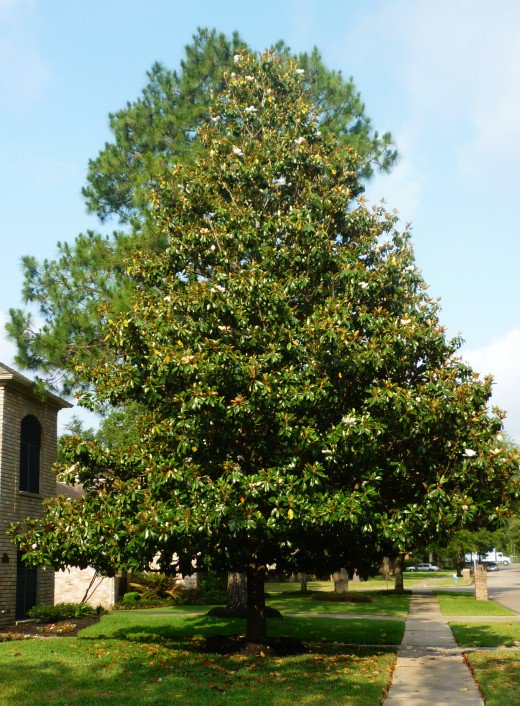
Magnolia Grandiflora, the big evergreen tree of the South.
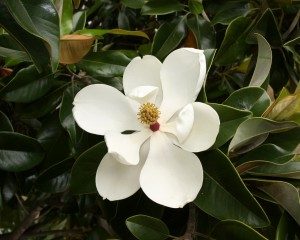
Some people batter and fry the petals.
A life time ago I was a foreign exchange student. I attended Whiteland College which was part of the University of London. I remember well three things about my time there. One was that they use Magnolia Blossoms as a condiment. I thought that strange at the time. It’s a very intense flavor. You can make it yourself by dicing then lacto-fermenting the blossoms for a few days, draining, then storing it in the frig adding a little white wine and sugar. You can do the same thing with Nasturtium seeds. They smell horrible for three days but they taste great once drained and stored. You can also flavor vinegar with the white petals.
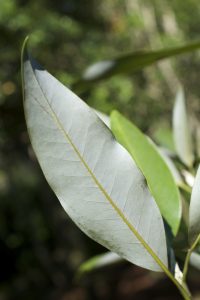
Magnolia virginiana leaves are easy to identify.
Magnolia Grandiflora leaves can be used like a bay leaf. In fact a close relative, the “Sweet Bay,” Magnolia virginiana, has been used that way for at least centuries and is highly esteemed for that use. The “Sweet Bay” a very common tree in damp areas and easy to identify. You can read about the Magnolias here. And what were the other two memorable items from the exchange? All the hallways in the college — which is now an upscale condominium — were named after local streets. So you didn’t live in room 213. It was 213 Wadsworth Way or the like. And right across the hedgerow was a hospital with the most awful name on a huge wrought iron banner over the drive way. It was: The Royal Hospital for the Incurably Ill.
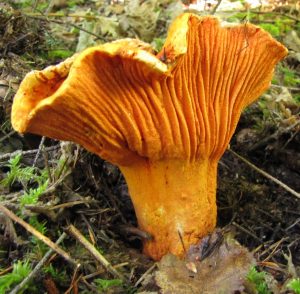
A red mold turns other mushrooms in to edible.
Lobsters… no, not the kind from the sea but the woods: Lobster mushrooms. As with many things the common name for Hypomyces lactofluoum can mislead. Lobster Mushrooms aren’t really mushroom but they also are… It takes some explaining. Hypomyces lactifluoum is a mold that infects certain species of mushrooms changing them into edible mushrooms. It usually infects mushrooms in the genera Russula and Lactiaria (though that last genus is ungoing changes so they might now be Lactifluus.) It creeps over the outside of the mushroom and takes over, turning it a reddish orange like a cooked lobster. And, it also changes the flavor of the mushroom towards tasting like seafood. One local mushroom it is known to commandeer is L. piperatus, which is too peppery to eat naturally. Once the mold has done it’s magic the “Milk Cap” still has “latex” but is not as peppery. The orange crust on the outside is flecked with little white pimples which is how the mold reproduces. When growing with pines they can look like orange peelings covered with needles. They can be found summer through fall. And specimens too old to eat can be used for dye.

Foraging classes are held rain or shine, heat or cold.
Foraging Classes: Foraging classes this weekend are in Orlando and Largo, some 130 miles apart. The class in Seminole County is around the tennis park at Sanlando Springs. So, if you live on the Seminole-Wekiva Bike Trail you might find that particularly interesting. Eagle Lake Park in Largo used to be a working ranch and grove providing a good array of edible wild plants to see. One interesting find in last week’s class in Ocala were a couple of edible mushroom species, Chanterelles and Old Man of the Woods. There’s a good environment for Chanterelles at Eagle Lake. Perhaps we’ll see some.
Saturday July 14th, Seminole Wekiva Trail, Sanlando Park, 401 West Highland St. Altamonte Springs, Florida 32714. 9 a.m. Meet at the first parking lot on your right after entering.
Sunday July 15th, Eagle Park Lake, 1800 Keene Road, Largo, FL 33771. 9 a.m. Meet at the pavilion near the dog park.
Saturday, July 21st, Bayshore Live Oak Park, Port Charlotte, Fl. 9 a.m. Meet at the parking lot at the intersection of Bayshore Road and Ganyard Street.
Sunday July 22nd, Lake Woodruff National Wildlife Refuge, 2045 Mud Lake Road, DeLeon Springs, FL. 9 a.m. Meet at the parking lot on right after crossing the railroad tracks. It will be a long, and hot class. Bring water. Bathrooms are Port-O-Lets.
Saturday, July 28th, Florida State College, south campus, 11901 Beach Blvd., Jacksonville, 32246. We will meet at building “D” next to the administration parking lot. 9 a.m.
Sunday, July 29th, Venetian Gardens, 201 E. Dixie Ave, Leesburg, FL 34748. 9 a.m. Meet at the parking lot near the pool.
Saturday, August 4th, Blanchard Park, 10501 Jay Blanchard Trail, Orlando, FL 32817. 9 a.m. Meet at the pavilion east of the tennis courts near the YMCA.
Sunday, August 5th, Boulware Springs Park, 3420 SE 15th St., Gainesville, FL 32641. Meet at the picnic tables next to the pump house. 9 a.m.
Saturday, August 11th, Dreher Park, 1200 Southern Blvd., West Palm Beach, 33405. As this is the hot summer time do you want to meet at 8 a.m.? Just north of the science center.
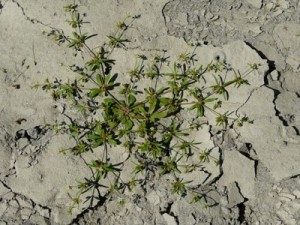
Carpetweed
One of the more common edible weeds underfoot in North America is Carpetweed, Mollugo verticillata. We saw it Sunday in Ocala. Scraggly if not scrawny the wispy plant does have the saving grace that it is all edible, raw or cooked and it requires very little cooking. Add it last. There are several non-edible species that can resemble it so there are some of key points to remember. First, it does not have any white sap, it grows in a circular mat, and the blossoms have five white sepals but usually only three stamens, sometimes four or five but usually three, which is a bit odd for a five-sepal plant. Look for it in dry, sandy locations including waste ground. For all of its wide-spread presence in North America it is actually native to the tropical Americas. You can read about Carpetweed here.

Green Deane Forum
Want to identify a plant? Looking for a foraging reference? Do you have a UFO, an Unidentified Flowering Object you want identified? On the Green Deane Forum we chat about foraging all year. And it’s not just about warm-weather plants or just North American flora. Many nations around the world share common weeds so there’s a lot to talk about. There’s also more than weeds. The reference section has information for foraging around the world. There are also articles on food preservation, and forgotten skills from making bows to fermenting food. One special section is “From the Frightening Mail Bag” where we learn from people’s mistakes. You can join the forum by clicking on the button in the menu line.

Green Deane DVD Set
All of Green Deane’s videos available for free on You Tube. They do have ads on them so every time you watch a Green Deane video I get a quarter of one cent. Four views, one cent. Not exactly a large money-maker but it helps pays for this newsletter. If you want to see the videos without ads and some in slightly better quality you can order the DVD set. It is nine DVDs with 15 videos on each. Many people want their own copy of the videos or they have a slow service and its easier to order then to watch them on-line. They make a good gift for that forager you know. Individual DVDs can also be ordered. You can order them by clicking on the button on the top right of this page or you can go here.
For more information about the classes go here.
This is weekly issue 312.
If you would like to donate to Eat The Weeds please click here. Or you can use my Go Fund Me link, or by writing to Green Deane POB 941793 Maitland FL, 32794.
Bacterial Considerations
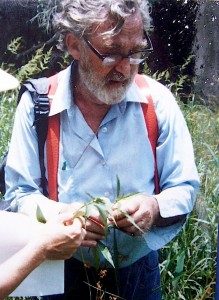
Dick Deuerling
I would go foraging some 24 years ago with the legedary Dick Deurling and Dr. Jose Gotts. Dr. Gotts, a professor at the University of Central Florida, was a character. Short, bald and portly he often went on a forage wearing only white shorts and dark horn-rimmed glasses. No shirt, no shoes… And nearly every time he would eat something controversial. I once saw him taste a Lubber, which is a large, toxic grasshopper. That would be about the time when Dick would announce to the group not to do what Jose had just done because Gotts grew up in war-torn Algeria and had an immune system primed differently than the rest of us. It was an interesting warning. Should you, for example eat fruit that has fallen on the ground? I do so the question perhaps is- – is this a harmful practice? The answer is a clear maybe yes maybe no.
Surprisingly there has been research on how much bacteria dropped food can pick up. It depends on what is dropped and where it lands. For example watermelon dropped on a tiled floor picks up a huge amount of bacteria almost instantly whereas a dry gummy bear on carpet very little. The harder the surface not only the more bacteria but the longer the bacteria can live which seems counter intuitive. Essentially it is the type of surface the food lands on that is important then how much bacteria is on that surface and lastly what kind of bacteria.
Excluding wild food, Americans get up to 800,000 cases of food poisoning a day… yes a day. And the rate of food poisoning from commercially grown food has doubled since 2000. About a third of it is from commercial fruits and vegetables and usually that’s contaminated with the bacteria E. coli, sometimes salmonellosis, rarely a Cyclospora parasite. Most wild plants and fruit don’t have that those pathogens. Another problem with commercial fruits and vegetable — compared to wild food — is that they can be handled by several customers and store personnel before you pick it up. Thus generally said wild food that is only touched by you is safer and usually the soil not contaminated. More so washing in plain water can also get rid of 98% of bacterial on such food though truth be told I can’t remember the last time I washed any wild food before consuming it. Not a worry high on my list.
If there is a high count of bacteria on a wild fruit or vegetable it will usually be on a bruised or rotting spot. I make jokes in classes about plants being watered by poodles but that’s not really a concern. Urine is fairly sterile and the rain washes off nearly everything. Where one does need to exercise some caution is where dogs (and especially cats) go to the bathroom. Their scat, particularly cats, can foster parasites in the soil. It might be that if you have pets your own back yard is the most hostile soil near you. Indeed most parasites in children come from pet-contaminated soil in their own yard, and usually from cat scat.
So what am I usually eating off the ground — usually dry sandy ground– or sidewalks? Persimmons, Jambul fruit, sea grapes come to mind and mulberries. I also eat purslane — mentioned earlier — where I find it not bothering to wash it unless it is a dusty location. And also note most research and commentary on food bacteria was written about commercially contaminated food and before we had a greater interest in our gut biome. It just might be that eating wild food adds diversity to our gut bacteria and increases our resillience.
We can detect at least two themes regarding food and bacteria: Commercial food is usually contaminated with stuff from human waste, so food grown over the septic drain field might be questionable. And some soil can be contaminated by cat or dog waste, usually your own back yard. I think it wise not to forage around a dog park and don’t let your dog or cat use your garden for a bathroom. That said I grew up in a house with a septic drain. Wild violets grew in that ditch profusely and my mother ate them raw all the time. She almost made it to 90 and would have made a century if she hadn’t smoked.
And while we should have some concerns about the wholesomeness of wild food I think a greater concern than bacteria is whether the ground or water has been polluted by non-bacterial means.


I’m these days living in Movendic Campus in Dubai -UAE. During my stay I usually enjoy spending some time in the big garden of the campus. Here I notice some patches of carpetweed. However, I can see some buds ;but no blossoms . I think the plant among others is meant to decorate the foot paths of the garden . A significant observation by me today is to see among the usual birds , like the European turtle doves ,pigeons , and little craws , one “houd houd” – Arabic for hoopoe . I wonder if it has fled from a dweller’s cadge or has come from the wild .
“The answer is a clear maybe yes maybe no.”
I’m going to use this at work on a daily basis from now on. : O)
Thanks for another great newsletter. I look forward to each and every one!
Dave
There is a standup green weed that grows along with the carpetweed, From the Dept Ag pictures it looks like virginia pepperweed, but I’m not sure. It appears to almost spontaneously grow overnight. Like they once thought frogs did. I wonder what it is?
thanks for your emails.
Your remarks about ” Bacterial considerations” are interesting and extremely useful. I’m sure people may gain a lot on complying with what has been explained . Many thanks .
l would like to add that the bird is relevant to Queen Belgeese of the famous Saba’a kingdum.